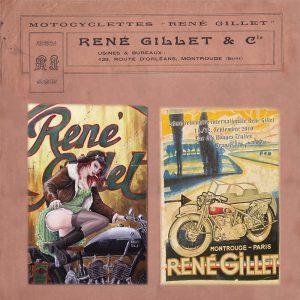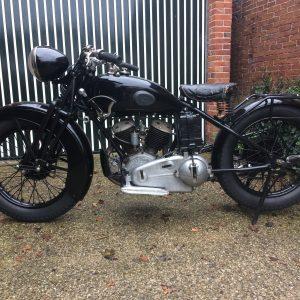René Gillet's father was a railroad worker. His father's father too. The family was certainly not rich, but they came around. There was no money for a follow-up study for René. At the age of 18, René Gillet went to Paris and found work there in a general construction workshop. He later started Ets. (Établissements, the company form) René Gillet, Paris. His first business premises were in the Villa Collet number 119 on Rue Didot in the 14e Paris district. He later moved to a location with more space on the Route d 'Orléans and Montrouge, a few kilometers further south. Gillet built high-quality, robust motorcycles.
The block in the right place
It all started with making motorized two-wheelers with the block above the front wheel. That was because young René Gillet made a lot of commuting kilometers every day. But young Gillet soon realized that a motorcycle had to be 'a whole' and not be an upgraded bicycle. And that he wanted to make motorcycles.
After that, the brand was the first to install engine blocks at the crankshaft level. Real motorcycle production started in 1902 with a single cylinder, but from 1904 45 degree V twins came from the workshop on the Route d'Orléans in Montrouge. Those V-twins, the first being a 500 cc side valve, would become 'the face' of Re René Gillet. The René Gillet motorcycles were nicknamed 'the French Harley-Davidsons'. In 1912 the René Gillets received parallelogram swing arm front forks and the first army orders came.
France as a world leader
It was in those early days of motorcycling that Peugeot, Griffon, Lurquin et Couderc, most of the names now forgotten, also started the motorized adventure. And so France became the largest motorcycle manufacturer in the world.
For the much needed 'Broem!' René Gillet mainly used the 746 and 996 cc V twins, which were popular with the French army and police. They were very appreciated by sidecar drivers.
After the Second World War, René Gillet built slightly modernized thick V-twins, but also mopeds and light two-stroke engines of 123 and 247 cc. Own blocks were always used.
Very reliable
In the first world war the 750 cc G twins and the 1000 cc J models proved to be very reliable. Later the police became an important customer. René Gillet also continued to manufacture the engine blocks himself, in 1929 the engines got (already) rear suspension.
The René Gillet motorcycles were sidecar tractors par excellence. And that was very nice for sidecar builder Bernadet. He only built the boxes, in 1955 the brand was taken over by Peugeot. René Gillet supplied the frames.
The large René Gillet engines were typically heavy for their time and were equipped with a single steel cradle frame. The front suspension was also 'des Rene Gillets': A kind of rocking arm front fork with a spring that killed the vibrations of the wheel. Smart!
The standard rear suspension was rigid, but a unique rear suspension was optional
Its construction was a sort of elemental cross between plunger ring and a cantilever system. The combination of front and rear suspension provided unprecedented comfort. But because the soldier's life should not be too comfortable and the army and police were of course economical with tax money, most René Gillet engines had a rigid rear frame.
The side valves turned a maximum of 4000 rpm and the power of the 750-1000 cc machines was 14 and 19 hp respectively. Early René Gillet engines had three gears, later four gears. Production of the V twins came to a standstill in WWII, but was then restarted.
René Gillet, however, remained in the past in terms of technology and supply. First the private buyers dropped out, then the government.
There are relatively many of these machines left
But few are currently being offered. They 'sit' with - increasingly aging - enthusiasts and are in museums, even in 'Russia'. Here in the Netherlands, René Gillet - like many other French motorcycle brands - has never really taken off.
Enthusiasts of these types of engines usually find each other within the VMC and the CFM. These are the respective veteran club and the club for French motorcycles. The added value of the CFM is spreading knowledge about French motorcycles, translating French texts about motorcycles, helping and stimulating each other and also maintaining some nice contacts. The CFM is an association that focuses on French motorcycles built from the early 1900s to the end of the 60s. In Germany there is an IG, an Interesse Gemeinschaft.
Strangely enough, there is still a fair amount of spare parts for the René Gillet within the enthusiastic circles
The prices of these machines are about or just above those of the American V twins of that time.
The red René Gillet in the photos is from the genetic engineer (and music lover) Peter Kuitwaard from Friesland. He has saved many a classic enthusiast from despair. In that respect he could be a brother of friend Jan Eggink. They are men whose motto is: "Can't exist, doesn't exist." And the fact that there are still such people is heart-conquering.
We were talking about René Gillet motorcycles in museums. Our friend Vyacheslav Sheyanov from Motorworld in Samara has a perfect one. And because his museum is a 'working museum', it can be driven. Also by you. Just look up motos-of-war.ru/en









I was INDEED to confuse: I thought Gillet was Belgian, in the article French… So there are two Gillet brands?
And then there are also the razor blades! It should not get any crazier!
Not to be confused with Gillet from 'les demoiselles de Herstal'… (FN, Saroléa and Gillet).
And so we have a trio! Many beautiful things have come from Belgium!